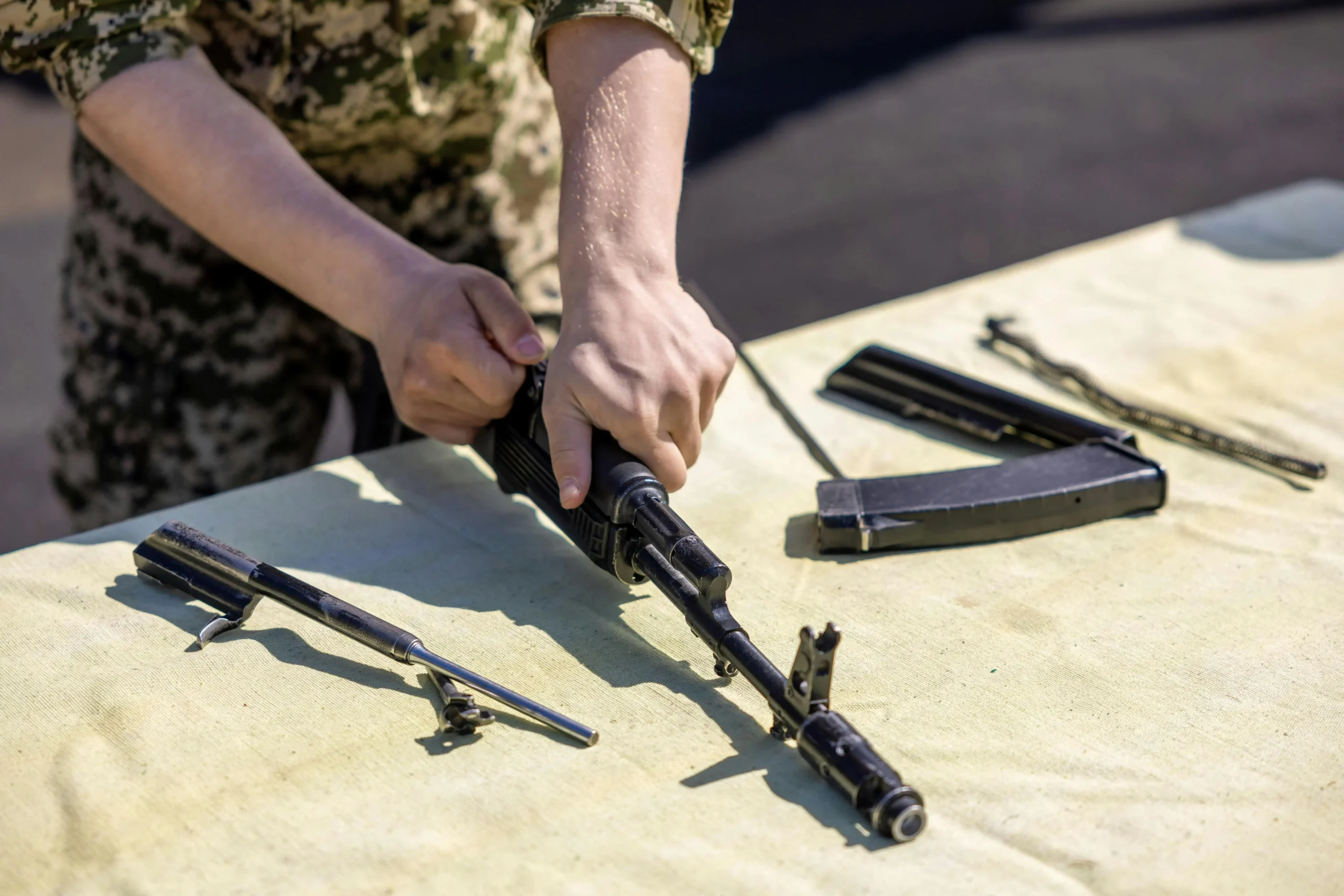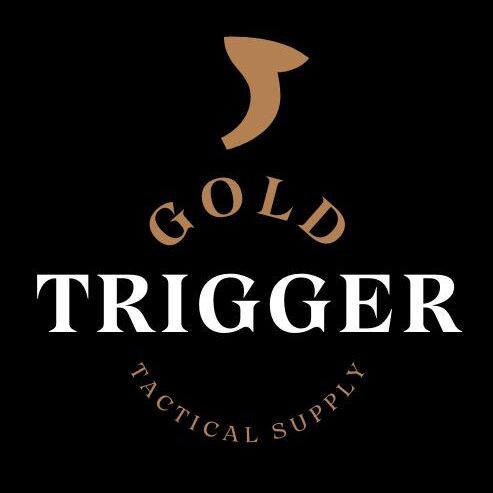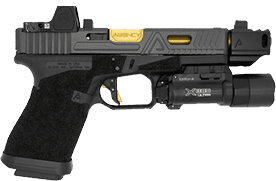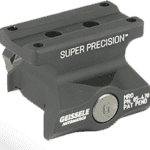Parts of a Gun: Essential Components & Upgrades Guide
Published on: August 27, 2025

Photo by Sergei Starostin
Reading time: 11 mins 45 secs
Over 393 million civilian firearms circulate throughout America, yet several owners still struggle to identify critical components beyond the basic trigger and barrel. This knowledge gap creates safety risks and limits your ability to maintain, upgrade, or troubleshoot firearms effectively when problems arise.
Understanding firearm anatomy isn’t just mechanical curiosity—it’s essential for safety, optimal performance, and making informed decisions about parts and upgrades. Whether you’re performing your first field-strip or considering aftermarket enhancements, component knowledge prevents costly mistakes and potentially dangerous malfunctions.
This guide dissects every critical firearm component across handguns and long guns, revealing how parts of a gun function together and when upgrades provide real benefits versus marketing hype.
Highlights
- Frame and receiver systems serve as the foundation, determining all component compatibility.
- Federal regulations now classify partially complete receivers as firearms requiring serialization.
- Aftermarket parts can enhance performance, but demand careful compatibility verification.
- Proper maintenance prevents the most common malfunctions while extending component lifespan.
- Platform-specific ecosystems like Glock and AR-15 offer extensive, proven upgrade paths.
Understanding Firearm Anatomy—The Foundation
Every firearm operates on identical principles: containing explosive force and directing it to propel projectiles accurately downrange. However, the mechanical complexity behind this concept involves dozens of precisely engineered components working in perfect synchronization.
Basic Firearm Components Every Owner Must Know
Frame or Receiver
This forms the firearm’s foundation, housing the trigger mechanism and providing secure mounting points for every other component. Think of it as your gun’s chassis—everything else connects here. Current ATF regulations specifically define frames and receivers as the serialized component requiring federal oversight and background checks.
Modern frames utilize either polymer construction for significant weight reduction or steel and aluminum alloys for maximum durability under extreme conditions. Each material offers distinct advantages depending on intended use and environmental demands.
Barrel
This performs multiple critical functions beyond simply guiding bullets. Internal rifling imparts stabilizing spin while the crown at the muzzle dramatically affects accuracy. Barrel length influences velocity, accuracy potential, and legal classification under various federal and state regulations.
Action
This encompasses all moving parts responsible for loading, firing, and ejecting cartridges. Whether operating a striker-fired pistol or bolt-action rifle, understanding your specific action type enables effective troubleshooting and proper maintenance procedures.
How Gun Parts Work Together
Modern firearms represent masterful mechanical engineering achievements. When you press the trigger, a precisely timed sequence occurs: the firing mechanism strikes the primer, igniting powder that creates rapidly expanding gases, driving the projectile down the barrel while simultaneously cycling the action for the next round.
This interconnected system means individual worn components affect overall performance. Weak recoil springs alter ejection patterns, while dirty barrels increase system pressure throughout the entire mechanism. That’s why comprehensive parts knowledge isn’t optional—it’s fundamental for safe, reliable operation.
Pistol Parts Breakdown—Handgun Essentials
Handguns compress remarkable mechanical complexity into surprisingly compact packages. Understanding these components helps maintain reliability while identifying meaningful upgrade opportunities versus cosmetic modifications.
Critical Pistol Components
Slide Assembly
This contains the barrel, recoil spring system, and firing mechanism components. This reciprocating mass cycles with each shot, making proper spring tension crucial for reliable function. Aftermarket slides frequently feature weight-reducing cuts or integrated optics mounting systems.
Trigger Assembly
This influences shooting accuracy more than any other single component. Factory triggers typically break between 5-8 pounds with varying degrees of consistency, while quality aftermarket options reduce weight to 3-5 pounds with dramatically improved consistency. However, trigger modifications can affect your firearm’s legal status under certain state regulations.
Magazine Systems
They appear deceptively simple but represent sophisticated spring engineering. Quality magazines utilize properly heat-treated springs and precisely angled feed lips. Substandard magazines create more reliability issues than virtually all other factors combined, making them critical components often overlooked by new shooters.
Proper loading technique is equally important—using quality magazine loaders like the Uplula speed loader prevents damage to feed lips and reduces spring fatigue during frequent training sessions.
Popular Pistol Part Upgrades
Performance Triggers
This improves shooting accuracy by reducing travel distance, eliminating over-travel, and shortening reset. Always verify local legal compliance before installing modified trigger components.
Barrel Upgrades
Upgrading the barrel delivers measurable accuracy improvements, particularly in stock Glock pistols. Aftermarket barrels often feature match-grade chambers and superior crown geometry.
Radian Weapons’ innovative Afterburner system combines compensators with precision barrels for substantial muzzle rise reduction during rapid fire. We’ve reviewed the best Glock compensators to help you choose the right one for your setup.
Grips
Enhanced grip modifications range from aggressive stippling to complete frame alterations. Improved surface texture helps maintain positive control during rapid firing sequences, while finger groove removal accommodates different hand sizes and shooting preferences. One good example is the X-Grip Magazine Spacer.
Handbrakes
Adding a handbrake helps improve weapon control, support consistent grip placement, and keep the firearm more manageable during rapid fire. Emissary Development produces quality handbrakes. Their Mini Handbrake is the most compact.
Rifle Parts Essentials—Long Gun Components
Rifles offer the most extensive customization possibilities, especially M-LOK accessories, through modular designs accommodating everything from precision long-range shooting to close-quarters tactical applications.
AR-15 Platform Breakdown
Upper Receiver
This houses your barrel, bolt carrier group, and charging handle assembly. Quality uppers utilize appropriate steel grades with precise machining for consistent headspace measurements. Knights Armament Company has earned recognition for producing military-specification upper receivers and rail systems meeting demanding operational requirements, including their legendary MP5 rail systems.
Rail systems themselves vary widely—with Picatinny and M-LOK being the two dominant standards.
Bolt Carrier Group
This cycles under tremendous force and extreme heat during operation. Quality BCGs incorporate proper coatings like nickel boron or nitride treatments for enhanced durability and simplified cleaning procedures. The bolt extension, gas rings, and extractor must function flawlessly together for reliable cycling.
Gas Systems
These regulate operating pressure through carefully calculated port sizing and tube length specifications. Direct impingement systems offer simplicity and reduced weight, while piston-driven systems operate cleaner but add complexity and weight. Neither approach is inherently superior; they represent different engineering philosophies that address specific requirements.
Precision Rifle Components
Stock Systems
These provide the critical foundation for accuracy potential. Adjustable stocks enable proper length of pull and consistent cheek weld, while free-floating designs eliminate barrel contact that negatively affects precision.
Magpul SGA stock for Remington 870 is one good example that delivers excellent ergonomics at a reasonable price point.
Trigger Assemblies
Trigger assemblies for precision applications require different characteristics than tactical triggers.
Benchrest triggers prioritize absolute consistency over rapid reset speed, while hunting triggers balance both qualities effectively.
Barrel
Barrel selection involves balancing weight, accuracy potential, and heat dissipation characteristics.
Heavy barrel profiles maintain precision during extended shooting sessions, while lightweight configurations reduce overall carry weight. Twist rate must properly match your intended ammunition weight range for optimal performance.
OEM vs. Aftermarket Parts—Making Smart Choices
Decisions between original equipment manufacturer and aftermarket components involve balancing cost, performance improvements, and reliability considerations across your specific requirements.
Original Equipment Manufacturer Advantages
OEM parts guarantee proper fitment while maintaining your firearm’s original design specifications.
Glock OEM components, for example, undergo identical quality control processes as complete pistols. This consistency eliminates compatibility concerns while preserving manufacturer warranty coverage.
Quality Control
Quality control for OEM parts typically exceeds aftermarket manufacturing standards. Original manufacturers test components through extensive cycle counts under extreme environmental conditions.
While aftermarket options might offer enhanced features, OEM components prioritize proven reliability above performance improvements.
Legal Considerations
Legal considerations matter significantly more than many shooters realize. Certain jurisdictions restrict aftermarket trigger modifications or magazine capacity enhancements.
OEM parts always comply with your firearm’s original legal classification, eliminating potential regulatory complications.
Aftermarket Parts Benefits and Risks
Aftermarket manufacturers drive industry innovation by addressing specific OEM limitations through advanced materials and engineering approaches.
Enhanced triggers, precision barrels, and ergonomic improvements frequently surpass factory specifications when properly implemented.
Quality Variations
Quality variations represent the primary aftermarket risk factor.
Premium manufacturers match or exceed OEM standards through rigorous testing protocols, while budget alternatives may compromise long-term reliability for initial cost savings.
Compatibility Issues
Compatibility issues can create dangerous malfunctions requiring professional gunsmith intervention.
Not all “compatible” parts function reliably across all model variations. Generation differences, minor specification changes, and tolerance accumulation create problems that experienced professionals recognize immediately.
Essential Gun Accessories—Beyond Basic Parts
Modern firearms benefit from carefully selected accessories that enhance capability without compromising fundamental reliability or adding unnecessary complexity.
Optics and Sighting Systems
Red dot sights have revolutionized pistol accuracy by providing precise aiming references that co-witness effectively with backup iron sights. Holosun delivers industry-leading battery life and proven durability, while Trijicon RMR systems establish military standards for operational ruggedness under extreme conditions.
Magnified optics serve precision rifle applications where target identification and extended-range accuracy become critical factors. Variable power scopes provide operational versatility, while fixed magnification models offer superior optical clarity at specific ranges with simplified operation.
Backup iron sight systems remain essential redundancy options. Magpul MBUS Pro sights fold completely flat when not needed but deploy instantly if primary optics fail. Quality backup sights have proven their worth in critical situations where equipment failure meant life-or-death consequences.
M-LOK rail covers also add comfort and protect your hands when running extended shooting sessions.
Lighting and Targeting Systems
Weapon-mounted lights aren’t merely tactical accessories—they’re essential safety tools for home defense applications where target identification becomes critical before engagement.
SureFire establishes industry benchmarks for output consistency and reliability, while Streamlight offers excellent performance at more accessible price points.
Cloud Defensive pushes technological boundaries with high-candela systems penetrating darkness at extended ranges beyond conventional capabilities. Their REIN series delivers measured performance exceeding many established competitors’ published specifications.
Pressure switch systems enable light activation without compromising your established grip position. Proper switch placement and wire management prevent operational snags while maintaining intuitive activation under high-stress conditions.
Maintenance Parts and Cleaning Supplies
Preventive maintenance using quality supplies significantly extends component service life while preventing dangerous malfunctions that could compromise safety or performance when you need reliability most.
Essential Replacement Parts
Springs
Springs represent the most frequently replaced wear components in firearms systems. Recoil springs gradually weaken with extended use, while magazine springs lose tension over thousands of loading cycles. Experienced shooters maintain spare spring sets for their most critical firearms.
Extractors and Ejectors
These experience tremendous mechanical stress during each firing cycle. These seemingly minor components cause major reliability issues when they begin failing. Quality replacements from established manufacturers like Glock or BCM ensure continued reliable function.
Gas System Components
Gas system components in AR-15 rifles require periodic replacement as part of normal maintenance. Gas rings, gas keys, and firing pins all experience gradual wear during operation. Using premium magazine loaders, like the Maglula speed loader, helps maintain the magazines that feed these precision systems reliably.
Professional Cleaning Equipment
Bore cleaning requires solvents specifically formulated to dissolve copper fouling and carbon buildup without damaging barrel steel. Breakthrough Gun Solvent offers military-grade formulations that work more effectively than traditional civilian cleaners.
Lubrication must balance corrosion protection with contamination resistance under diverse environmental conditions. Excessive oil attracts dirt and debris, while insufficient lubrication accelerates component wear. Modern synthetic lubricants offer superior performance across a wide range of extreme temperatures.
Ultrasonic cleaning systems handle detailed cleaning that manual methods simply can’t match effectively. Small components emerge completely clean without requiring disassembly or intensive scrubbing. Professional gunsmiths rely heavily on ultrasonic systems for precision maintenance work.
Legal Considerations for Gun Parts
Understanding current legal requirements prevents innocent mistakes that can result in serious federal felony charges carrying significant prison sentences and permanent loss of gun rights.
Federal Regulations and Compliance
Recent ATF rules now classify frames, receivers, and certain partially complete components as “firearms” requiring background checks and serialization.
Lower receivers and pistol frames fall under these federal restrictions, while complete bolt carrier groups typically don’t require individual serialization—only the receiver portion demands federal oversight.
Import restrictions significantly limit the availability of certain foreign-manufactured components. Some European often need domestic modification, certification, or licensing before they can legally enter the U.S., which drives up price and scarcity in the marketplace.
National Firearms Act items like suppressors and short-barreled rifles involve extensive federal paperwork, mandatory tax stamps, and substantial waiting periods. Even threading your barrel for future suppressor attachment can create legal complications under certain state regulations.
State and Local Variations
Magazine capacity restrictions vary dramatically between different states and localities. Components legal in Texas might constitute serious felonies in California or New York. Research your specific local requirements before purchasing capacity-enhanced magazines or related components.
In many states, “assault weapon” laws are based on specific features rather than the firearm itself. Cosmetic or ergonomic additions like pistol grips, collapsible stocks, or flash hiders can trigger a legal reclassification of your rifle as an “assault weapon.” Even minor modifications can unintentionally make your firearm illegal, potentially leading to severe legal penalties.
Certain jurisdictions require special permits for purchasing ammunition components or firearm parts. Others restrict specific types of expanding ammunition entirely. Stay continuously informed about evolving local regulatory requirements.
Buying Guide—Selecting Quality Components
Smart purchasing decisions require thorough research, careful compatibility verification, and objective quality assessment beyond marketing claims and online reviews.
Research and Compatibility Verification
Model identification extends far beyond basic manufacturer names and caliber designations. Generation differences, production runs, and regional variations significantly affect component compatibility. Glock Gen 5 triggers won’t fit Gen 3 frames despite superficial similarities.
Manufacturer technical specifications provide crucial dimensional and compatibility information. Detailed drawings, torque specifications, and material requirements eliminate expensive guesswork. Quality manufacturers consistently provide comprehensive technical documentation.
Compatibility databases maintained by reputable dealers save considerable time while preventing costly purchasing mistakes. These resources show which specific parts fit particular firearm models accurately. Always utilize these verified resources before making component purchases.
Quality Assessment Criteria
- Material Specifications: These reveal true manufacturing quality standards. Proper steel grades, appropriate heat treatment, and durable surface finishes indicate genuine attention to engineering details. Bargain components frequently utilize inferior materials with inadequate quality control processes.
- Brand Reputation: This carries significant weight in firearms component selection. Companies like Magpul earned their reputations through consistent quality delivery and responsive customer support. Their products command premium pricing but deliver proven long-term reliability.
- Customer Feedback: This provides valuable real-world performance insights. However, distinguish between informed technical evaluations and casual user opinions. Experienced competitive shooters and professional gunsmiths offer significantly more valuable perspectives than recreational users.
Troubleshooting Common Component Issues
Understanding typical failure modes helps identify worn components before they cause dangerous malfunctions that could compromise safety or mission-critical performance.
Feeding and Extraction Problems
Magazine-related issues cause the majority of ammunition feeding problems in modern firearms. Weak springs, damaged feed lips, or accumulated debris prevent reliable feeding cycles. Quality magazines from proven manufacturers virtually eliminate most feeding-related reliability issues.
Extractor problems typically manifest as stuck cases or inconsistent ejection patterns. Worn extractors gradually lose proper tension, while damaged ejector components cause erratic case ejection behavior. These components experience extreme mechanical stress, requiring periodic inspection and replacement.
Chamber dimensional variations affect feeding reliability significantly. Oversized chambers can cause dangerous case head separation, while excessively tight chambers prevent proper cartridge feeding. Professional gunsmiths utilize precision measurement tools to verify chamber specifications accurately.
Accuracy and Performance Degradation
Barrel wear gradually reduces accuracy potential through throat erosion and crown damage accumulation. High-volume shooting accelerates wear rates, particularly when using corrosive surplus ammunition. Borescope inspection reveals an internal barrel condition that external examination cannot detect.
Scope mounting issues frequently cause mysterious accuracy problems that frustrate shooters. Improper torque specifications, base misalignment, or ring damage create inconsistent point-of-impact shifts. Quality mounting systems eliminate these performance variables.
Trigger consistency affects precision shooting accuracy more than most realize. Creep, over-travel, and reset variations introduce human error into the shooting equation. Precision triggers from quality manufacturers provide consistent release characteristics that enhance accuracy potential.
Future Technology Trends
Emerging technologies promise notable improvements in firearm performance, user experience, and operational capabilities across diverse applications.
Advanced Integration Systems
Smart optics integrate sophisticated ballistic computers with real-time environmental sensors for precise holdover calculations. These systems automatically calculate complex trajectory solutions for extended-range engagements. Current technology costs remain elevated, but prices continue declining as adoption increases.
Modular design trends enable rapid configuration changes for different operational requirements. Single rifle platforms accommodate multiple barrel lengths, various calibers, and different stock configurations seamlessly. This modularity reduces total ownership costs while maximizing operational versatility.
Some electronic trigger systems allow adjustable pull weights and reset timing. While not widely adopted in mainstream semi-auto rifles or pistols due to regulatory and reliability concerns, their potential for extreme consistency in precision shooting is well-documented.
Material Science Innovations
Advanced polymer formulations significantly reduce component weight while maintaining structural performance comparable to aluminum or steel in many firearm applications. Magpul played a leading role in modernizing and popularizing polymer firearm components.
Exotic metal alloys, including titanium and scandium, offer superior strength-to-weight ratios compared to conventional materials. These advanced materials appear in premium components where performance advantages justify higher costs.
Minor caveat: Titanium has unique wear characteristics (galling) and can be brittle in some contexts, so it’s not a universal upgrade over steel.
Advanced ceramics offer high wear and corrosion resistance and are being explored for specific firearm components like firing pins, nozzles, or bearings. However, brittleness under impact and high manufacturing cost limit their current widespread application.
Conclusion
Mastering gun parts transforms you from a passive owner to a knowledgeable user capable of maintaining, upgrading, and troubleshooting firearms effectively throughout their service life. This expertise prevents dangerous malfunctions while enabling intelligent purchasing decisions that enhance performance without sacrificing reliability.
If you’re ready to upgrade your firearms with proven components that deliver measurable performance improvements, browse our extensive selection of OEM and aftermarket parts from industry-leading manufacturers. You may call us at (713) 485-5773 as well.
Disclaimer: The information provided in this comprehensive gun parts guide is for educational purposes only and reflects general industry knowledge as of the publication date. This content does not constitute legal advice, and Gold Trigger is not responsible for any modifications, installations, or uses of firearm parts that may violate federal, state, or local laws. All firearm modifications and parts installations should comply with applicable laws and regulations.
Users assume full responsibility for ensuring their firearm modifications are legal in their jurisdiction and are performed safely. We strongly recommend having all firearm parts installed by a licensed gunsmith to ensure proper installation, safety, and compliance with applicable laws. For any legal questions regarding firearm modifications, ownership, or compliance, always consult with an attorney who specializes in firearm laws in your jurisdiction.
When in doubt about any aspect of firearm modifications or legal compliance, consult with qualified gunsmiths, legal professionals, or law enforcement agencies. Improper installation or use of firearm parts can result in serious injury, death, or legal consequences.
Always follow manufacturer guidelines, safety protocols, and applicable laws when working with firearms and firearm parts. This guide is not a substitute for professional training, proper safety practices, or legal counsel. Firearm safety is paramount, and users should seek appropriate training and education before attempting any modifications or repairs.
Prices, availability, specifications, and legal requirements mentioned in this guide are subject to change without notice. Always verify current information with manufacturers, legal authorities, and qualified professionals before making purchases or modifications.





Comments